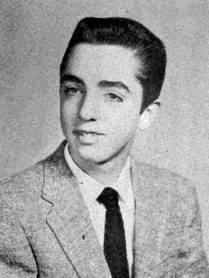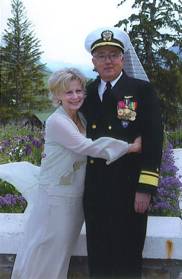 Phil
Phil Phil & DianeAfter today, when, in your thoughts, you envision Tom Cruise flying upside down in "Top Gun," your mind should immediately shift gears...you will now remember another graduate of the Top Gun school in Miramar, California who is, by the way, a 1958 graduate of Hicksville High School.
Phil & DianeAfter today, when, in your thoughts, you envision Tom Cruise flying upside down in "Top Gun," your mind should immediately shift gears...you will now remember another graduate of the Top Gun school in Miramar, California who is, by the way, a 1958 graduate of Hicksville High School.
What a wonderful career this man has had, and it grows day by day. If you flash back to that spring day of 1958...the graduation ceremony at the high school... there would be little doubt in anyone's mind that this man would be successful in whatever he did.
Following graduation from high school, Phil went off to college in Oswego. He distinguished himself in the hallowed halls of the high school and continued that tradition at the University of New York at Oswego. After graduation from Oswego, Phil enlisted in the United States Navy. He went to flight school in Pensacola, Florida and received a commission as a Naval Aviator in 1963. His official designation at the time was Radar Intercept Operator.
Over the next several years, Phil served in the following fighter squadrons: VF-31 on-board USS Saratoga, VF-151 on-board Constellation and VF-213 on-board USS Kitty Hawk during Western Pacific cruises. His tours included combat duty in Vietnam. Additionally, Phil served as Commanding Officer of VF-154 and VF-121, the West Coast F-4 Phantom Training Squadron.
The epitome of ones career in the navy, as an officer, is to have command. Phil realized this dream in 1985 when he was designated as Captain of the USS Kansas City. He served in this capacity until February of 1987. The Kitty Hawk was on deployment in the Indian Ocean. His second command, aboard the USS Constellation, was from May 1987 until June of 1988. It was December 1987 when Phil was selected to Rear Admiral (lower half). This was the culmination of years of dedicated service that saw Philip move through the ranks to a pinnacle not many reach.
He assumed command of Fighter Airborne Early Warning Wing U.S. Pacific Fleet in July 1989 and was subsequently selected for Rear Admiral (upper half) in June 1991. He then reported as Deputy Director, Space and Electronic Warfare (OP-094B) in October 1991 and subsequently as Director, Aviation Plans and Requirements Division (N-880) in January 1992. In July 1994, he reported as Deputy Director, Space and Electronic Warfare (OPNAV N6).
He has had a diverse set of shore assignments to include Director Navy Space Programs, Commander Fighter Wing, US Pacific Fleet, CNO Plans and Programs (N-8), Director Aviation Plans and Requirements (N-78B), Deputy Director, Space and Electronic Warfare (N-6B), Commander Naval Space Command, and Director, Space and Electronic Warfare (N-6). His first Washington tour was a member of the Chief of Naval Operations in the Program Planning Directorate as Special Assistant for Air Warfare.
Phil retired from the navy in 1995. His personal awards include the Distinguished Service Medal, Legion of Merit (4), Meritorious Service Medal (5), Air Medal (15), and the Navy Commendation Medal with Combat "V" (5).
It was in December of 1995 when Phil joined Northrop Grumman in Baltimore. Since joining Northrop Grumman at the executive level, he has led the Electronic Sector in the development of strategic, surveillance, and intelligence systems for the Department of Defense and the four services. A leader in transformation and network solutions, he initiated the Navy's use of space and tactical sensors in the Naval Fires Network program. Congress and DOD have recognized this effort for Rapid Deployment Capability in support of Operation Enduring Freedom. This effort is the cornerstone of the services ability to conduct "Time Critical Strike and Time Sensitive Targeting".

